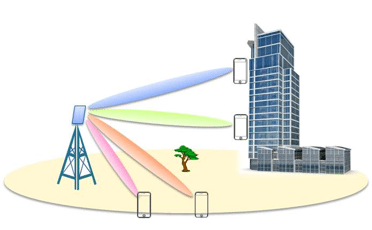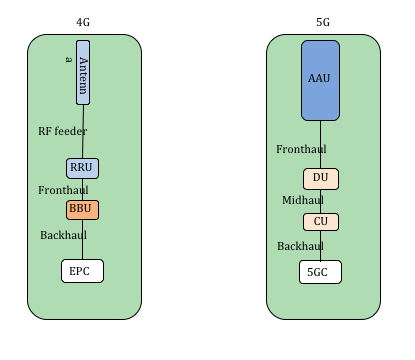As 5G networks’ commercial deployment approaches, research in standardization, technologies, services, ecosystem, and deployment modes are increasingly deepening. It has been proven that services, rather than technologies, are the main driving forces of network development. Therefore, the functions and performance required for the implementation of 5G networks need to be analyzed from the perspective of application scenarios and service requirements.
The eMBB is a deterministic requirement during early 5G network deployment, and is also the core momentum in the process of promoting the development of the entire 5G industry. All early standard formulation, commercial use, testing, and verification of products are based on such requirement.
This document analyzes and describes the challenges that carriers are facing from the perspective of early 5G network deployment, especially the problems encountered during gNB (5G Base Station) deployment, the preparation of 5G bearer networks, O&M complexity resulting from network virtualization and network slicing, impact on carriers’ organizational architecture, and also provides recommended solutions.
Massive MIMO featured gNB
In eMBB scenarios, the core requirement of 5G networks is for a significant increase in access rates. Rich spectrum resources are available on the millimeter-wave frequency bands at frequencies of 26/28 GHz or above. This means that achieving a cell access capability of 10 Gbps or above would be very easy. However, the coverage and network construction cost is a tremendous constraint. Considering the industry chains and 5G candidate spectrum in the world, the sub 6 GHz frequency band is gradually becoming the spectrum resource that needs to be preferentially considered during early 5G network deployment, and 3.5 GHz is the most popular choice. The 5G Deployment and Commercial Consideration released by Ovum reported that, through the second quarter of 2017, 15 markets where the 3.5 GHz spectrum has either been allocated to 5G networks or been used in 5G testing and verification .
In the fully competitive market, it’s difficult for each carrier to obtain more than 100 MHz from 3.5 GHz spectrum resources. Therefore, how to utilize limited spectrum resources to deliver expected access rates in 5G networks is the greatest challenge that carriers are facing. At the same time, macro base-station construction has a high priority during early 5G deployment, and carriers are still highly concerned about site density and network construction costs. In addition, how to solve the coverage shortcoming of the 3.5 GHz frequency band and achieve decent coverage by reusing the existing 4G site infrastructure will be the key factor in reducing the site number of 5G gNBs.
Among all the 5G key technologies, Massive MIMO is the core technology to improve spectrum efficiency. With the precise beam forming capability provided by large-scale antenna arrays, Massive MIMO allows multiple users to share the same spectrum resources by means of space division multiplexing, so that the cell throughput can be increased by multiple times. During the recent field test held in Guangzhou, ZTE and China Mobile demonstrated over 6 Gbps downlink cell peak throughput by utilizing the MU-MIMO feature of Massive MIMO (using the 100MHz bandwidth of the 3.5GHz frequency band). As a matter of fact, Massive MIMO can not only significantly improve system capacity but also increase network coverage. This is of great importance in supporting the continuous coverage of 5G networks and reducing site density and network construction costs.

It is generally acknowledged that, compared with 2.6 GHz LTE, 3.5 GHz 5G NR results in much poorer coverage due to many factors such as propagation loss, penetration loss, and time-division multiplexing. Therefore, more base stations need to be constructed to guarantee the same coverage level. By relying on its rich experience accumulated in the communication industry and thorough deep analysis of 5G systems, ZTE demonstrated that the 3.5 GHz 5G network can be co-sited with the 2.6 GHz LTE network based on the Massive MIMO technology and dual-antenna transmission CPE terminals via theoretical simulations and field tests. This will largely reduce carriers’ network construction investments in early 5G network deployment.
Regarding the product implementation of Massive MIMO, besides the specific requirements on hardware design, the optimization of algorithms and network performance is also important. With the large-scale commercial deployment of Pre5G Massive MIMO worldwide, ZTE has accumulated rich channel estimation and multi-user multi-stream algorithm optimization experience. This lays a solid foundation for first-mover advantages in 5G. Actually, the advantages of 5G products on low frequency bands are very obvious in terms of maturity and performance. In addition, different from the traditional deployment mode (antennas + base stations), Massive MIMO base stations will undergo remarkable changes during installation, debugging, and optimization. The large-scale commercial use of Pre5G Massive MIMO will help vendors make full preparations in the whole process.
The above analysis demonstrates that, the Massive MIMO technology can not only increase the spectral efficiency of 5G networks by multiple times but also further enhance the coverage capabilities of 3.5 GHz 5G networks. Both 4G and 5G networks can be co-sited to reduce early network deployment costs as well as difficulty.
FlexE-Based 5G Transport
The reconstruction and upgrade of transport networks are the prerequisite for 5G network deployment. With the fast development of 5G standards, commercial 5G network products and 5G terminals, the reconstruction and upgrade of transport networks becomes urgent. Carriers will invest more money on the reconstruction of existing transport networks before the large-scale deployment of 5G networks. Mobile carriers must select the most proper reconstruction plans for their transport networks by fully taking into account the 5G network architecture and gNB deployment modes.
Broader spectrum and Massive MIMO are used in 5G networks. RAN Interfaces need to be re-split because the original CPRI interface is not applicable to 5G networks. Considering the centralization and virtualization of some baseband functions, the baseband part is divided into the Distributed Unit (DU) and Centralized Unit (CU). Network deployment modes vary with service requirements and transport networks. DUs can be deployed together with AAUs on the site side, centralized in the equipment room of the convergence node to form a resource pool, or deployed together with the CUs in the central equipment room.
Compared with 4G networks, the 5G eMBB access capability is increased by over 100 times, which raises requirements for transport bandwidth. Due to the flexible deployment requirements of 5G CUs and DUs, transport networks need to deal with fronthaul, midhaul, and backhaul scenarios. If both the transport requirements of 4G networks and the coordinated 4G&5G network requirements are taken into account, transport networks may face more difficulties. In the coming 5G era, massive IoT access, ultra-reliable low-latency communication, and inter-DC on-demand connectivity after network virtualization will be supported. It can be anticipated that 5G transport networks will be confronted with unprecedented complexity and flexibility.
Currently, the standardization of 5G transport is being advanced. The FlexE-based 5G transport solution proposed by ZTE can not only flexibly process mixed access scenarios involving fronthaul, midhaul, and backhaul but also easily deal with inter-DC on-demand connection requirements after Network Functions Virtualization (NFC). By means of flexible slicing, ZTE Flexhaul solution can deliver not only extra-high broadband capability to eMBB services but also fit for ultra-low-latency forwarding channels to latency-sensitive services, thereby Flexhaul becomes the 5G-oriented ideal transport solution.

Cloud Native-Based 5GC
Virtualization is an inevitable trend of the future core network, while end-to-end network slicing allows carriers to easily cope with differentiated requirements in vertical industries and provide customized services for customers in different fields in an agile way. After network virtualization, the software-to-hardware ratio is gradually increased, the network service operation mode with the characteristics of muti-network coexistence and multi-service concurrency relies more on intelligent algorithms, and high requirements are also raised for carriers’ organizational architecture. Carriers’ network O&M teams must gradually transform into lifecycle management teams focusing on new service development and network slicing.
The cloud native & micro service architecture used in the ZTE 5GC supports high bandwidth, massive MTC, low latency and high reliability in an on-demand manner within the same network. End-to-end network slicing allows the unified orchestration, scheduling, and management of resources in the core network, transport network, and access network. Diverse service capabilities are implemented by means of flexible function orchestration and on-demand resource scheduling. In addition, the ZTE carrier-grade DevOps system enables carriers to develop, test, operate and optimize new services, greatly shorten the time to market of new services and reduce networks’ O&M complexity.
The standardization of 5GCs is later than the 5G RAN schedule. Some carriers may plan to deploy 5G NR first and then introduce 5GC during the 2nd stage. Other carriers may plan to construct complete 5G networks at the beginning. Regardless of which mode is used, core network virtualization does not rely on the progress of 5GC standardization. After core network virtualization, both EPC and 5GC will be loaded to the virtualization platform in the form of software applications. Therefore, after the freezing of standards, 5GCs can be introduced by means of smooth software upgrade. The virtualization reconstruction of core networks during the 4G phase will not only reduce the O&M costs of 4G networks but also make good preparations for the introduction of 5G networks.
Conclusion
As the commercial deployment of 5G networks approaches at a fast pace, many carriers are actively pursuing the verification of new technologies, formulating future-oriented evolution strategies, and exploring innovative business modes of ICT services. During this stage, it is of vital importance to select a correct path and pace.
5G network deployment will cover many aspects such as the access network, transport network, core network and NMS. ZTE takes lead in the pre-commercial 5G end-to-end solutions and system performance, and has already carried out the world’s largest 5G pre-commercial field test successfully. It already worked together with China Mobile and Qualcomm to complete the world’s first R15-compliant end-to-end interoperability test. We firmly believe that these advantages can help world-leading carriers become the first to launch their 5G commercial services and seize market opportunities in the 5G era.

